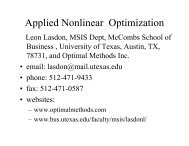[PDF] ALIO Back Matter
[PDF] ALIO Back Matter
[PDF] ALIO Back Matter
Create successful ePaper yourself
Turn your PDF publications into a flip-book with our unique Google optimized e-Paper software.
SA04<br />
3 - Mathematical Models Implemented for the Propagation and<br />
Mitigation of the Avian Influenza Virus (H5N1) in Colombia<br />
Diana Ramirez, Scientific Director, Fundacion Centro de<br />
Investigacion en Modelacion Empresarial del Caribe, Carrera 53 No.<br />
79 - 315 L202, Barranquilla, Colombia, dramirez@fcimec.org<br />
Given the recent influenza pandemic outbreak, the World Health Organization has<br />
been even more worried about the strategies that the countries have been<br />
implementing in order to control the spread of the disease. Also, they have been<br />
alerting about the coming of a new pandemic outbreak of the avian influenza<br />
(H5N1) among humans, which is said to be even more dangerous. Mathematical<br />
models have been studied, for decades now, on the propagation of every influenza<br />
virus, yet each country presents its own reality. This research is based on the<br />
implementation of these models in Colombia, not only to model the propagation of<br />
the disease within the country but also for an optimal implementation of the control<br />
and mitigation strategies needed for a future outbreak of this disease.<br />
4 - Discrete Event Simulation to Determine when Performing a Breast<br />
Cancer Biopsy is Cost-effective<br />
John Jairo Rios Rodriguez, Universidad de los Andes, Cra 1 Este #<br />
19A-40 Ed. Mario Laserna, Bogotá, Colombia,<br />
joh-rios@uniandes.edu.co, Mario Castillo<br />
This work develops a Discrete Event Simulation model programmed in Arena® to<br />
evaluate the appropriate moment to perform a biopsy to women who are at risk of<br />
developing breast cancer. The model follows women’s disease progression and<br />
performs a cost-effectiveness analysis. Disease progression parameters were obtained<br />
from published data; only direct medical costs were considered and were based on<br />
local information.<br />
5 - A Tool for Management of the Patient-visit Network within a Chilean<br />
Public Health Service<br />
Mario Tarride, University of Santiago, Chile, Industrial Engineering<br />
Department, 3769, Ecuador Avenue, Santiago, Chile,<br />
mario.tarride@usach.cl, Oscar C. Vasquez, Julia Gonzalez,<br />
Tamara Riquelme, Gisel Lagos<br />
This paper presents a tool for management of the patient-visit network within a<br />
Chilean public health service based on the simulation of system. This is developed in<br />
Powersim Studio 2005, management requirements according to the Chilean’s Law<br />
are certificated and its validation performance is realized. Results show<br />
determination coefficients upper to 0.8 and average simulation time of 20 minutes.<br />
In addition, management scenarios to reduce the patient-visit queue are simulated<br />
and analyzed.<br />
■ SA04<br />
Aula 372- Third Floor<br />
OR Applications I<br />
Contributed Session<br />
Chair: Elias D. Niño, Professor, Universidad del Norte, KM5 Via Puerto<br />
Colombia, Barranquilla, Colombia, enino@uninorte.edu.co<br />
1 - Multiobjective Optimization Algorithm with Self-adaptation for<br />
Scheduling Problems<br />
Jaime Mora-Vargas, Head Graduate Program in Industrial<br />
Engineering, Tec de Monterrey, Carr. Lago de Guadalupe km 3.5,<br />
Col. Margarita Maza de Juárez, Atizapán de Zaragoza, 52926,<br />
Mexico, jmora@itesm.mx, Nestor Velasco-Bermeo,<br />
Miguel Gonzalez-Mendoza<br />
It is well known that the computational complexity of scheduling problems has<br />
been determined to be NP-hard and the a different scenario solution is a basic<br />
consideration in order to solve a problem with its most realistic modeling. Although<br />
this paper is limited to analyze a bi-objective objective function the results obtained<br />
show the effect a self-adaptation module has on the evolution and the improved<br />
results over a MOGA with a Local Search strategy implemented and a plain MOGA.<br />
2 - Optimization of Infomation Exchange in Distributed<br />
Decision Networks<br />
Hela Masri, Larodec Laboratory, Institut Superieur de Gestion,<br />
University of Tunis, 41 Rue de la Liberte, Le Bardo, 2000, Tunisia,<br />
masri_hela@yahoo.fr, Adel Guitouni, Saoussen Krichen<br />
A decision network is a set of interconnected nodes through heterogeneous edges.<br />
Nodes are information provider, information consumer or information relay. We<br />
propose a nonlinear integer mathematical program to optimize the multiple quickest<br />
paths between multiple nodes. Each edge is has a capacity, a transmission delay and<br />
a cost. The decision problem is to optimize information exchange. Solution include<br />
the quickest transmission paths and scheduling of the information transmission.<br />
<strong>ALIO</strong> / INFORMS International – 2010<br />
22<br />
3 - A Mathematical Programming Model Applied to the Optimization of<br />
Cleaning Procedures in a Sunlight Collector Field<br />
Pedro L. González-R, PhD, Escuela Superior de Ingenieros.<br />
Universidad de Sevilla, C/Camino de los Descubrimientos, s/n,<br />
Sevilla, Spain, pedroluis@esi.us.es, David Canca<br />
Nowadays, renewable energy, and more specifically those based on solar energy, are<br />
a clear alternative to the fossil fuel energy. Many solar energy plants are opening<br />
throughout the world. Procedures for increasing these solar plants efficiency pass<br />
through an appropriate policy in cleaning and maintaining processes. However,<br />
these aspects are not usually taken into account in the actual design of plants. In<br />
this work a mathematical model is introduced in order to address this issue.<br />
4 - A New Metaheuristic Based on Deterministic Finite Automaton for<br />
Multi-objective Optimization of Combinatorial Problems<br />
Elias D. Niño, Professor, Universidad del Norte, KM5 Via Puerto<br />
Colombia, Barranquilla, Colombia, enino@uninorte.edu.co,<br />
Carlos J. Ardila, Carlos Paternina-Arboleda<br />
In this paper we state a metaheuristic based on Deterministic Finite Automaton<br />
(DFA) for multi-objective optimization of combinatorial problems. First, we propose<br />
a new DFA based on Swapping (DFAS). DFAS allows the representation of feasible<br />
solutions space for combinatorial problems. Last, we define an algorithm that works<br />
with DFAS, it is named Exchange Deterministic Algorithm (EDA). The results of<br />
EDA were compared with the results of a Pareto Local Search (PLS).<br />
■ SA05<br />
Velez Sarfield- Second Floor<br />
Retail Pricing and Inventory Decisions:<br />
Theory and Applications<br />
Cluster: Revenue Management and Pricing<br />
Invited Session<br />
Chair: Juan-Carlos Ferrer, Associate Professor, Pontificia Universidad<br />
Católica de Chile, Casilla 06 Correo 22 Santiago, Escuela de Ingeniería,<br />
Santiago, RM, Chile, jferrer@ing.puc.cl<br />
1 - A Multi-period Competitive Model of Retail Revenue Management<br />
Pedro León, Research Engineer, Pricing-UC, Casilla 306 Correo 22,<br />
Santiago, RM, Chile, pleon@pricing.uc.cl, Juan-Carlos Ferrer,<br />
Hugo Mora<br />
This paper analyzes a multi-period stochastic retail revenue management problem<br />
considering competition. An optimal pricing policy is obtained using a game<br />
theoretic approach combined with dynamic programming, for periodic revisions in a<br />
non-cooperative duopoly market where two firms competing with substitutable<br />
perishable products have perfect information on the competitor’s inventory level at<br />
all times. Managerial insights are provided to understand the impact of competition.<br />
2 - On Pricing of Retail Products with Demand Learning:<br />
A Real Application<br />
Eduardo Flores, Research Engineer, Pricing-UC, Casilla 306 Correo<br />
22, Santiago, RM, Chile, eflores@pricing.uc.cl, Juan-Carlos Ferrer<br />
We address the pricing problem of a retailer offering a fixed inventory of products in<br />
a finite sales horizon. The demand is characterized by a Poisson process with an<br />
uncertain arrival rate. The retailer may choose to learn about that rate throughout<br />
the season. Computational results indicate that incorporating learning into the<br />
pricing decision produces a significant increase in expected revenues. An empirical<br />
study in a Chilean retail chain supports the results of this research.<br />
3 - Risk Averse Retail Pricing with Robust Demand Forecasting<br />
Diego Oyarzún, Research Engineer, Pricing-UC, Casilla 306 Correo<br />
22, Santiago, RM, Chile, doyarzun@pricing.uc.cl, Juan-Carlos Ferrer,<br />
Jorge Vera<br />
Good demand estimates are the key to an effective pricing decision making.<br />
However, they are subject to high uncertainty levels due to various factors that are<br />
unpredictable or difficult to model, and pricing decisions are therefore risky.<br />
Uncertainty is explicitly considered for two coefficients of both a linear and an<br />
exponential demand function, price expressions are derived and a criterion is<br />
proposed for defining the degree of risk aversion.<br />
4 - Effective Inventory Management in a Pharmaceutical Retail Chain<br />
Juan-Carlos Ferrer, Associate Professor, Pontificia Universidad<br />
Católica de Chile, Casilla 06 Correo 22 Santiago, Escuela de<br />
Ingeniería, Santiago, RM, Chile, jferrer@ing.puc.cl, Pedro León,<br />
Diego Oyarzún<br />
We present an application of demand forecasting models to significantly reduce<br />
stock-outs in the pharmaceutical industry, where revenues are low and extremely<br />
variable at a SKU/store level. The trade-off between lost sales and inventory is<br />
modeled. Promotions, lead-times, fill rates and replenishment policies are taken into<br />
account. The model keeps a balanced and coordinated inventory flow between the<br />
distribution center and the 310 stores. We conclude presenting the implementation<br />
results.


![[PDF] ALIO Back Matter](https://img.yumpu.com/17932960/2/500x640/pdf-alio-back-matter.jpg)
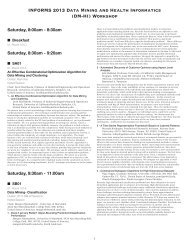
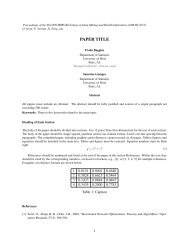
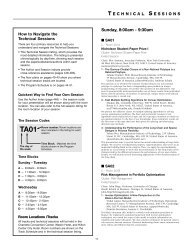
![[PDF] Charlotte Back Matter](https://img.yumpu.com/17933057/1/190x245/pdf-charlotte-back-matter.jpg?quality=85)

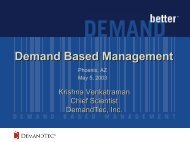
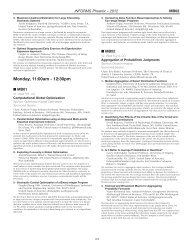

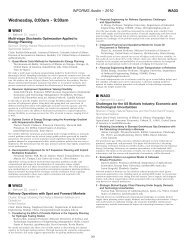
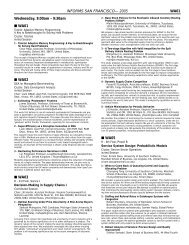
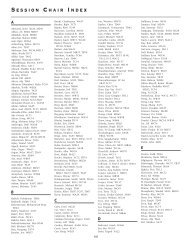
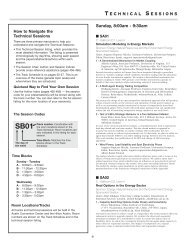
![[PDF] Monday, 8:00am - 9:30am](https://img.yumpu.com/17932954/1/190x245/pdf-monday-800am-930am.jpg?quality=85)
